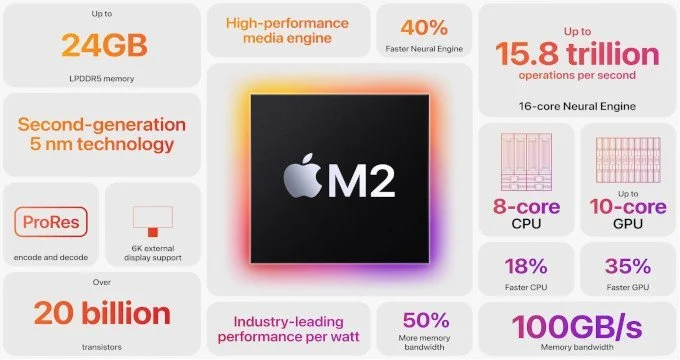M2 chip (based on the A15 chip) with a 8 core CPU and 10 core GPU produces an 18% upgrade in CPU, a 35% upgrade in GPU, a 40% faster neural engine and supporting up to 24 Gb of ram over the original M1 SOC. This added power makes the M2 run hotter which is fine if your work only demands the entire system for 30 minutes or less. If you work with video editing, 3D modeling and rendering or more demanding programs, this fanless system may become too hot and will throttle down to cool the computer, a MacBook Pro with active cooling is more your need.
The M2 Pro is rumored to have a 12 core CPU (8 performance and 4 efficiency cores), M2 Max will come in at 12 core CPU and 32 or 40 core GPU and M2 Ultra at 24 core CPU and 64 or 80 core GPU. (Luke Miani who predicted the rumored Mac Studio). The M2 Extreme (4 M2 Max chips connected together) will have a 48 core CPU and 128 or 160 core GPU and 256Gb of ram.
https://en.wikipedia.org/wiki/Apple_M1
Apple announced the M2 SoC on June 6, 2022 at WWDC, along with the MacBook Air and the 13 inch MacBook Pro. It is the successor to the Apple M1. The M2 is made with TSMC's "Enhanced 5-nanometer technology" N5P process and contains 20 billion transistors, a 25% increase from the previous generation M1. The M2 can be configured with up to 24 gigabytes of RAM and 2 terabytes of storage. It has 8 CPU cores (4 performance and 4 efficiency) and up to 10 GPU cores. The M2 also increases the memory bandwidth to 100 GB/s. Apple claims CPU improvements up to 18% and GPU improvements up to 35% compared to the previous M1.
Apple's M1 (based on the A14 chip) Mac processor family began with the M1 in 2020 and expanded — literally — with the M1 Pro, M1 Max and M1 Ultra. The M1 Ultra is made of two M1 Max chips. If you want a glimpse of where the processor business is headed, check out Apple's new M1 Ultra processor.









